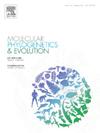Copepod phylogenomics supports Canuelloida as a valid order separate from Harpacticoida
IF 3.6
1区 生物学
Q2 BIOCHEMISTRY & MOLECULAR BIOLOGY
引用次数: 0
Abstract
Copepods are small crustaceans that are ubiquitous in aquatic environments. They are particularly abundant in marine and freshwater plankton, marine sediments, and as parasites or commensals of other aquatic organisms. Despite their abundance and importance, phylogenetic relationships among copepods are poorly resolved. The validity of higher-level taxa, including several orders, has continued to be controversial throughout the 21st century. This study has two main goals: first, to use phylogenomic data to assess relationships among the four major copepod orders: Calanoida, Cyclopoida, Harpacticoida, and Siphonostomatoida, which together include more than 98 % of copepod species diversity, and second, to test the validity of the recently proposed order Canuelloida. Towards these goals, we sampled 28 copepod transcriptomes and genomes spanning 20 families and 5 orders, including the first transcriptome of a representative of Canuelloida. We identified 2,527 single copy protein coding genes comprising 939,460 amino acid (aa) positions and 530,269 informative sites. All phylogenetic analyses support a monophyletic Podoplea (i.e., the superorder comprising all copepod orders except for Calanoida and Platycopioida) with Calanoida as its sister taxon. We find robust support across all methods for Canuelloida as a distinct order separate from the traditionally recognized Harpacticoida (Oligoarthra). Contrary to several recent studies of smaller sets of nuclear genes or mitochondrial genomes, we recover Cyclopoida and Harpacticoida as sister taxa and find that gene tree discordance analysis rejects the alternative topologies. Transcriptomic data are promising for resolving the backbone of the copepod phylogeny but collecting and sequencing the nearly 15,000 species of copepods, many of which are infrequently encountered and less than 1 mm in size, remains a major hurdle.

桡足类系统基因组学支持Canuelloida是一个从Harpacticoida中分离出来的有效目。
桡足类是一种小型甲壳类动物,在水生环境中无处不在。它们在海洋和淡水浮游生物、海洋沉积物以及其他水生生物的寄生虫或共栖物中尤其丰富。尽管桡足类丰富且重要,但它们之间的系统发育关系却没有得到很好的解决。在整个21世纪,包括几个目在内的高级分类群的有效性一直存在争议。本研究有两个主要目的:第一,利用系统基因组学数据评估四种主要桡足目:Calanoida、Cyclopoida、Harpacticoida和Siphonostomatoida之间的关系,这四种目占桡足类物种多样性的98% %以上;第二,检验最近提出的Canuelloida目的有效性。为了实现这些目标,我们对28个桡足动物的转录组和基因组进行了采样,涵盖20个科和5目,其中包括Canuelloida代表的第一个转录组。共鉴定出2527个单拷贝蛋白编码基因,包含939,460个氨基酸位点和530,269个信息位点。所有的系统发育分析都支持单系足足目(即包括除Calanoida和Platycopioida以外的所有桡足目的超目)以Calanoida为其姐妹分类单元。我们发现强大的支持在所有方法Canuelloida作为一个不同的顺序从传统上公认的Harpacticoida (Oligoarthra)分开。与最近对较小的核基因或线粒体基因组的研究相反,我们恢复了Cyclopoida和Harpacticoida作为姐妹分类群,并发现基因树不一致分析拒绝了替代拓扑结构。转录组学数据有望解决桡足动物系统发育的主干问题,但收集和测序近15,000种桡足动物仍然是一个主要障碍,其中许多不常见且尺寸小于1 毫米。
本文章由计算机程序翻译,如有差异,请以英文原文为准。
求助全文
约1分钟内获得全文
求助全文
来源期刊
CiteScore
7.50
自引率
7.30%
发文量
249
审稿时长
7.5 months
期刊介绍:
Molecular Phylogenetics and Evolution is dedicated to bringing Darwin''s dream within grasp - to "have fairly true genealogical trees of each great kingdom of Nature." The journal provides a forum for molecular studies that advance our understanding of phylogeny and evolution, further the development of phylogenetically more accurate taxonomic classifications, and ultimately bring a unified classification for all the ramifying lines of life. Phylogeographic studies will be considered for publication if they offer EXCEPTIONAL theoretical or empirical advances.

 求助内容:
求助内容: 应助结果提醒方式:
应助结果提醒方式:


